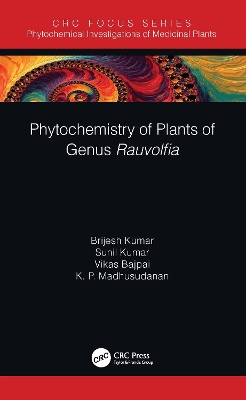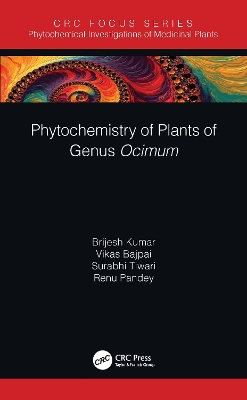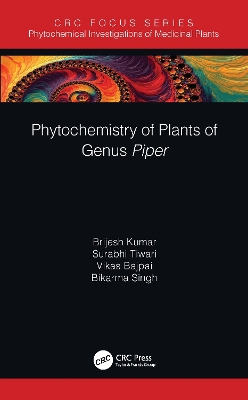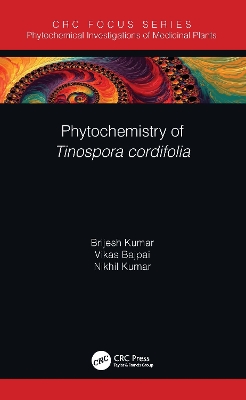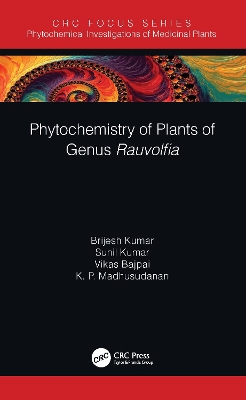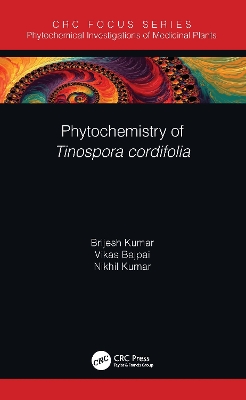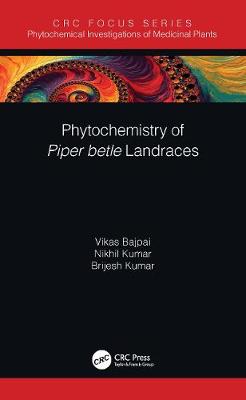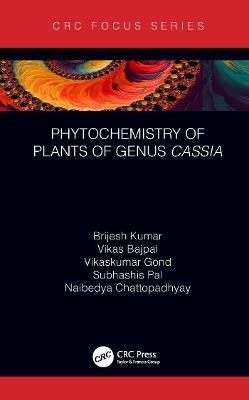Phytochemical Investigations of Medicinal Plants
8 total works
Phytochemistry of Plants of Genus Rauvolfia
by Brijesh Kumar, Sunil Kumar, Vikas Bajpai, and KP Madhusudanan
Rauvolfia species, commonly known as Sarpagandha, has been traditionally used in Ayurveda for curing high blood pressure, hypertension, snake bites, fever, and mental illnesses. Due to its wide variety and differences in chemical composition, it is necessary to develop an efficient and reliable method for rapid screening and determination of phytochemicals in the extracts of the Rauvolfia species. This book will provide qualitative and quantitative comparative phytochemical investigations of selected medicinal plants from the Rauvolfia genus using liquid chromatography-mass spectrometry (LC-MS) techniques. The results will help in assuring the efficacy and safety of Rauvolfia herbal products.
Features:
- Collection of Ayurvedic features and scientific evidence of important medicinal plants.
- Discusses chemical signatures for the identification of Rauvolfia (Sarpagandha) and its products.
- Easy-to-use analytical procedure for quality control of Rauvolfia and its products.
Phytochemistry of Plants of Genus Ocimum
by Brijesh Kumar, Vikas Bajpai, Surabhi Tiwari, and Renu Pandey
Ocimum species has been used as a traditional remedy for various ailments such as arthritis, bronchitis, cold, conjunctivitis, diarrhea, dysentery, and flatulence, as well as for healing wounds and lowering blood glucose level. These are characterized by variations in their morphology such as the shape, size and pigmentation of leaves, which cause differences in chemical composition and affect the commercial value of this genus. This book describes phytochemical investigations of Ocimum species using LC-MS/MS instruments to study qualitative and quantitative variations of phytochemicals in different Ocimum species.
Features:
- Collection of Ayurvedic features and scientific analytical and pharmacological evidence of most important medicinal plants of genus Ocimum.
- Chemical signatures for the identification of Ocimum species.
- Easy-to-use analytical procedure for quality control of plants of Ocimum species and its herbal products.
Phytochemistry of Plants of Genus Piper
by Brijesh Kumar, Surabhi Tiwari, Vikas Bajpai, and Bikarma Singh
Piper is the representative genus of family Piperaceae. Piper species are pan-tropical in distribution and found in both the hemispheres. As the king of all spices, black pepper, Piper nigrum, led to the global expeditions culminating in the discovery of India and the new world. Piper species have been reported to possess various pharmacological activities such as insecticidal, antibacterial, anti-inflammatory, antiplatelet, anti-hypertensive, antithyroid, antitumor activities and hepatoprotective properties. Botanical authentication of the plants of Piper species is difficult because of the morphological similarity among the species. This book describes ultra-performance liquid chromatography coupled with triple quadrupole electrospray tandem mass spectrometry in multiple reactions monitoring (MRM) mode to study the quantitative variation of thirteen bioactive markers in different plant parts of ten Piper species.
Features:
- Collection of Ayurvedic features and scientific evidence of the most important medicinal plants of Piper species.
- Describes chemical signatures for identification of Piper species.
- Provides easy-to-use analytical procedure for quality control of Piper species and its products.
Phytochemistry of Tinospora cordifolia
by Brijesh Kumar, Vikas Bajpai, and Nikhil Kumar
Tinospora cordifolia stem is used as a tonic, vitalizer, and as a remedy for metabolic disorders to treat allergies, diabetes, dysentery, jaundice, heart diseases, leprosy, rheumatoid arthritis, skin diseases, and urinary disorders. It shows anti-inflammatory, analgesic, antipyretic actions and immunosuppressive effects. This book focuses on providing gender and geographical location-based differences in the phytoconstituents of T. cordifolia by the liquid chromatography mass spectrometric method. These methods have potential use in the quality control of T. cordifolia and the screening of herbal preparations.
Features:
- Compilation of ayurvedic features of one of the most important plants of the Indian system of medicines.
- Useful for all ayurvedic practitioners, researchers, faculty, students, and herbal product manufacturers.
- Application of advance hyphenated LC-MS techniques for variation study in phytoconstituents.
Phytochemistry of Plants of Genus Rauvolfia
by Brijesh Kumar, Sunil Kumar, Vikas Bajpai, and KP Madhusudanan
Rauvolfia species, commonly known as Sarpagandha, has been traditionally used in Ayurveda for curing high blood pressure, hypertension, snake bites, fever, and mental illnesses. Due to its wide variety and differences in chemical composition, it is necessary to develop an efficient and reliable method for rapid screening and determination of phytochemicals in the extracts of the Rauvolfia species. This book will provide qualitative and quantitative comparative phytochemical investigations of selected medicinal plants from the Rauvolfia genus using liquid chromatography-mass spectrometry (LC-MS) techniques. The results will help in assuring the efficacy and safety of Rauvolfia herbal products.
Features:
- Collection of Ayurvedic features and scientific evidence of important medicinal plants.
- Discusses chemical signatures for the identification of Rauvolfia (Sarpagandha) and its products.
- Easy-to-use analytical procedure for quality control of Rauvolfia and its products.
Phytochemistry of Tinospora cordifolia
by Brijesh Kumar, Vikas Bajpai, and Nikhil Kumar
Tinospora cordifolia stem is used as a tonic, vitalizer, and as a remedy for metabolic disorders to treat allergies, diabetes, dysentery, jaundice, heart diseases, leprosy, rheumatoid arthritis, skin diseases, and urinary disorders. It shows anti-inflammatory, analgesic, antipyretic actions and immunosuppressive effects. This book focuses on providing gender and geographical location-based differences in the phytoconstituents of T. cordifolia by the liquid chromatography mass spectrometric method. These methods have potential use in the quality control of T. cordifolia and the screening of herbal preparations.
Features:
- Compilation of ayurvedic features of one of the most important plants of the Indian system of medicines.
- Useful for all ayurvedic practitioners, researchers, faculty, students, and herbal product manufacturers.
- Application of advance hyphenated LC-MS techniques for variation study in phytoconstituents.
Phytochemistry of Piper betle Landraces
by Vikas Bajpai, Nikhil Kumar, and Brijesh Kumar
Piper betle (betel vine) a pan-Asiatic, tropical plant, which can also grow under mild subtropical areas, is essentially grown for leaves which are chewed with array of additives besides slaked lime. The plant is cultivated widely in India and its surrounding areas. Phytochemistry of Piper betel landraces presents a brief on the distribution, historical and cultural aspects, and properties ascribed to this plant in the ancient texts. Phytochemical and pharmacological information has also been included to underscore the importance of this plant in the present time. A detailed account on metabolic profiling employing modern methods is included, such as real-time, direct analysis of the flight mass spectrometric method and chemometric analysis for characterization of the available biodiversity and signatures specific to gender and geographical location. It was also possible to identify the gender of unknown landraces, with the help of principal component analysis.
Features:
- Elaborates on the chemical diversity within Piper betle.
- Piper betle leaves have mouth freshening antimicrobial compounds.
- Use of chemical signatures for the identification of different Piper betle landraces, their gender and geographical locations.
Phytochemistry of Plants of Genus Cassia
by Brijesh Kumar, Vikas Bajpai, Vikaskumar Gond, Subhashis Pal, and Naibedya Chattopadhyay
Cassia is an indigenous plant in Africa, Latin America, Northern Australia and Southeast Asia. Several Cassia species are of high commercial and medicinal significance since they are used as spices and in traditional medicines. Currently plants from genus Cassia is in great demand due to their immense medicinal properties. Cassia species have various pharmacological activities such as antibacterial, analgesic, antiinflammatory, antiarthritic, hepatoprotective, antitumor, antifertility, antifungal, antioxidant, antileishmaniatic, antimicrobial, CNS and hypoglycaemic activitiy. Different class of compounds reported from Cassia species are anthraquinones, phenolics, flavonoids, chromenes, terpenes, proanthocyanidins, coumarins, chromones and lignans. The taxonomy and nomenclature of Cassia species are quite complex. It is very difficult to differentiate them due to their overlapping morphological characters and close similarities. This usually leads to misidentification and misinterpretation of the components.
Features:
- Presents collection of Ayurvedic features and scientific evidence of most important medicinal plants of Cassia species
- Chemical signatures for identification of Cassia species
- Easy to use analytical procedure for quality control of Cassia species and its products.
